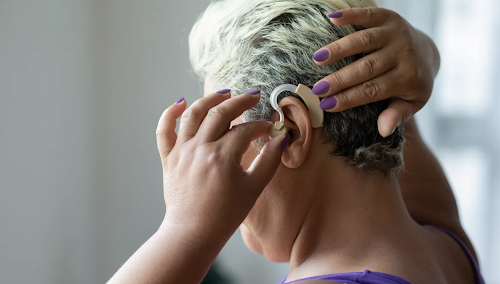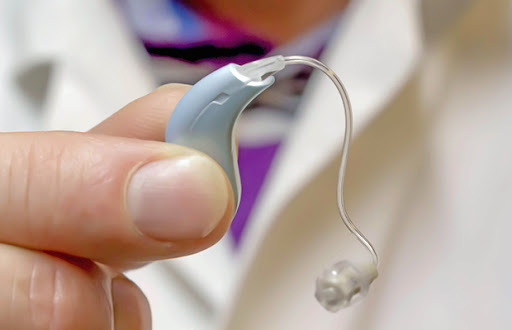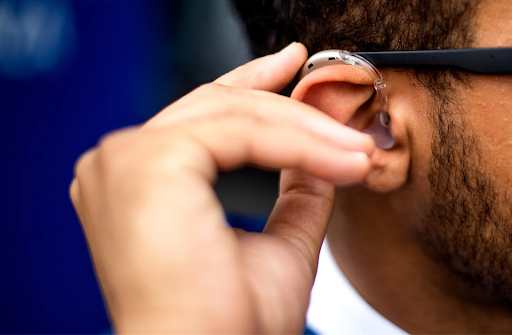October 13, 2023

By: AEOP Membership Council Member Annika Joshi
For many years, I have volunteered at senior living centers. I would arrange miniature piano concerts for the residents there, and most of the time, they enjoyed it. However, there were times when they would not. For example, one time, a lady complained throughout the whole performance about it interrupting her lunch and hurting her ears. At the time, I was a 15-year-old, and my ego was incredibly bruised – especially since I had only received positive comments before.
This happened a few times, and I started to notice a pattern. Residents with hearing loss wearing assistive listening devices (ALDs) did not enjoy listening to music as much as others. I conducted research and realized that hearing aids and cochlear implants are not great for music. Additionally, I learned that ALDs are prone to infection, incredibly expensive and uncomfortable. It made complete sense that the residents did not enjoy listening to music or hearing anything at all.
This bout of research inspired me to develop a low-cost, piezoelectric material that could be incorporated into ALDs to make them more compact, functional, and accessible. But what exactly is a piezoelectric material? And how would it help?
The Piezoelectric Effect
Discovered in 1880 by Jacques and Pierre Curie, the piezoelectric effect describes the ability of certain materials to naturally convert mechanical energy into electrical signals and vice versa. To simplify this, you tap it, and it produces a voltage; you zap it, and it vibrates. This is caused by the displacement of electrons within these non-centrosymmetric compounds when they are compressed or stretched.
Energy Harvesting
A widely researched application of piezoelectric materials involves reusing and harvesting energy. This research has the potential to create a new array of devices that are self-powered, which would make them more efficient, less faulty and less expensive. For example, many have explored utilizing typing fingers to power laptops, tablets and cell phones. When piezoelectric chips are placed below a keyboard, they will be compressed every time a key is hit. This compression will produce a current that can be sent back into the device to power it.
In a similar fashion, in 2014, researchers in China (Lu et al.) published a study on incorporating PZT, a piezoelectric ceramic, into pacemakers. The idea behind the study was that a person’s heartbeat could compress or vibrate the ceramic and produce enough voltage to power the pacemaker.

Both studies would effectively reuse and save energy. In an era of climate change and decreasing supply of commonly used, non-renewable resources, piezoelectric materials and energy harvesting resources could greatly help.
Sensory Reception
Sensory receptor damage is a severe, global problem, causing a lack of sensation in affected areas. For example, 11 million people suffer from burns annually. Burns cause damage to receptors in the skin, limiting victims’ abilities to recognize touch. Piezoelectric materials can be used to convert taps and bends into electrical signals, which would simulate nerve signals (Zhu et al.). If interfaced with the broken and exposed nerves, patients could regain the ability to feel. This could also be incorporated into prosthetics so patients could feel new synthetic body parts.
Additionally, sensory receptor damage in the inner ear causes hearing loss. Over 466 million people require hearing rehabilitation, and it is predicted that approximately 2.5 billion people will have some form of hearing loss by 2050. Current hearing aids are complex structures of magnets and coils and are highly expensive. However, a piezoelectric device could automatically produce electric signals that could connect to the cochlea, and ultimately the brain, when exposed to sound vibrations. Piezoelectric PZT foam was tested for this application on guinea pigs by Mukherjee et al. and proved to help them recover their hearing by up to 50 decibels.
Sensory receptor damage is a problem that weighs more heavily on low- and middle-income areas. Piezoelectric materials have the potential to simplify devices and their manufacturing processes, reducing the costs of currently expensive treatments. This could narrow socioeconomic gaps and open up opportunities for people living in economically disadvantaged areas.
Impact
Overall, piezoelectric materials can perform actions within devices that currently require many parts, making them more efficient, more accessible and less expensive. Scientists are recognizing the potential of these unique materials in a number of applications. And soon, the Curie brothers’ simple discovery will not only power our products, but also our people.
References
Lu, Bingwei, et al. “Ultra-Flexible Piezoelectric Devices Integrated with Heart to Harvest the Biomechanical Energy.” Scientific Reports, vol. 5, no. 1, 5 Nov. 2015, https://doi.org/10.1038/srep16065.
Mukherjee, Niloy, et al. “The Piezoelectric Cochlear Implant: Concept, Feasibility, Challenges, and Issues.” Journal of Biomedical Materials Research, vol. 53, no. 2, 31 July 2002, pp. 181–187., https://doi.org/10.1002/(sici)1097- 4636(2000)53:2<181::aid-jbm8>3.0.co;2-t.
Zhu, Miaomiao, et al. “Highly Shape Adaptive Fiber Based Electronic Skin for Sensitive Joint Motion Monitoring and Tactile Sensing.” Nano Energy, vol. 69, 2020, https://doi.org/10.1016/j.nanoen.2019.104429.
Find a Volunteering Opportunity
Visit our Program Volunteers page for a tool to find the best opportunity for you.
eCYBERMISSION Mini-Grant
The eCYBERMISSION Mini-Grant is intended to support teachers/program leaders as they implement eCYBERMISSION with their teams. Educators (formal and informal) of students in grades 6-9 are encouraged to apply.
